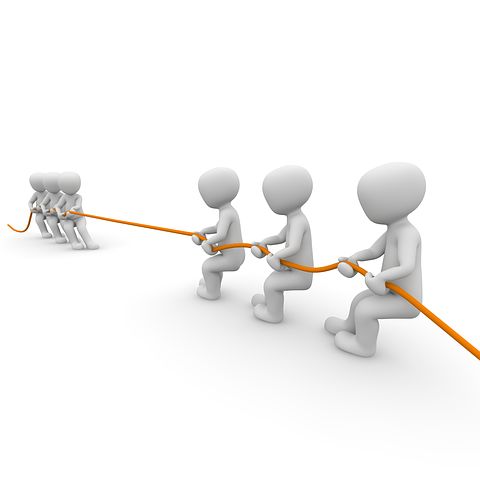Think about a time in your life where you made a big change. I mean a really big change, like quitting smoking or getting yourself out of debt and starting a savings account. Now think back to what made you successful. Did you just wake up one morning and proclaim to yourself that you were going to stop doing this and start doing that? Or, at some point, did you take some time to think about steps you could take to make this change become more realistic and stick? Chances are, if you were successful, you did the latter and developed some strategies that helped ensure your success.
Now go back and think about a time when you failed in your efforts to change. Did you actually develop a list of strategies and execute them, or did you fly by the seat of your pants and hope for the best? This is what I would term using willpower.
Yes, we all know someone who one day just decided they were going to quit smoking and actually did! Just cold turkey, straight will-powered their way to never picking up a cigarette again. That’s awesome if you happen to be one of these people, but unfortunately, most of us are not. We might be able to rely on our willpower for a couple of days, a week, or even a month, but at some point, we will eventually fall back into our old behaviors.
This is the essence of what I see going on everyday in the individuals who I try to help lead healthier lives. There is the common misconception out there that one needs a super-human amount of willpower in order to ensure their success in losing weight or starting and continuing an exercise program, when in reality, this is far from the truth. Sure, you need some willpower to actually stop the harmful behaviors and begin healthier ones, but in the end, it is your strategies that will allow you to succeed after the excitement and newness fade. lf you only take away one thing from this article – aways remember that, over the long run, strategies will trump willpower every time.
Here is my top 5 list of dietary strategies followed by my top 5 list of exercise strategies that work for myself, my clients, and can for you too!
Top 5 Dietary Strategies
1.) Be organized and have a plan
Let’s say your goal is to clean up your diet and the way you intend to go about it is to stop eating processed foods. This means your days of buying and relying on prepackaged foods and most frozen meals are about to come to an end. Instead, you will be buying fresh whole foods and will be required to cook. Do you have a plan in place to replace the Goldfish crackers you snack on in the afternoon and the frozen lasagna you routinely pop into the oven for dinner? I advise clients to sit down once a week and write down what they plan on eating for the entire week – breakfast, lunch, and especially dinner. Once it’s written down in black and white, you can then go to the store, purchase what you will need, and have it ready when you need it.
2.) Have a go-to person for help
At some point you are going to run into some difficulties. Trust me, there is an overabundance of nutrition-related information floating around everywhere, and everyone claims to have the answer. I’ve said it before – just because eating or not eating a particular food works for your best friend does not automatically mean it’s going to work for you. We are all unique and have different chemical reactions to different foods. Find someone you trust, who understands you, and who can really help you when your plan needs some tweaking.
3.) Have emergency meals and snacks in the house at all times
It’s been a long day. You get home even later than normal and you’re starving. Now you have to think about making dinner, which is the last thing in the world you want to do. It’s moments like these where we often cave and go through the drive-thru window or throw in the frozen pizza. It’s the exact same thing I used to do…that is, until I developed strategies. Now I always keep almonds in the house. When I get home and I’m hungry, I simply eat a handful of almonds, and in about 5 minutes I’m not as hungry anymore. I’ve also increased my chances that I will not go the frozen pizza route. Instead, I always keep some frozen salmon and broccoli in the freezer for those times of need. Simply brush the fillets with olive oil, season with salt and pepper, squeeze some lemon and you have an incredibly easy and healthy meal on your table in 25 minutes.
4.) Carry an emergency pack if you travel
There is no doubt that eating healthy while traveling is more difficult to do, but it’s not impossible. Long periods of time between meals and delayed flights often lead to eating whatever happens to be quick and available. Consider packing some of the following to bring with you as they lend themselves well while on the road: apples, carrot sticks, sugar snap peas, raw nuts, hard boiled eggs, protein powder, and Lara or RX Bars (while not perfect, they can be good when in a pinch). These are not meant to be meals, but can buy you time until you’re able to find healthier options.
5.) Figure out your trigger foods
A trigger food is one that increases the likelihood of a binge. More often than not it involves sugar or refined carbohydrates, both of which are highly addictive. Mine was basically any type of sugar, especially baked sweets. I couldn’t eat just one brownie – it had to be the whole pan! This is where I realized everything in moderation did not work for me. A few M&M’s everyday never wound up just being a few. I always had to go all in. It became fairly obvious to me that in order to kick my sugar habit I needed a strategy. Allowing myself to have sweets one day per week, and one day only, proved to be what worked for me.
Top 5 Exercise Strategies
1.) Be organized and have a plan
Sound familiar? There is just no getting around this one. Not knowing what to do and getting bored are two of the biggest reasons people end up quitting exercise and not achieving “results.” Consider hiring a personal trainer. Have them draw up a couple of workouts for you and then go over them once or twice or until you feel comfortable doing them on your own. Then after 4-8 weeks meet with your trainer again and repeat the process. You’ll learn what to do, and by keeping your workouts fresh, you won’t become bored and you’ll get better results too. Always remember that having ANY plan is better than having no plan at all.
2.) Have a go-to person for help
This should sound familiar too. Once you have your plan (workouts), don’t just assume everything will be smooth sailing. Situations will arise from time to time that you may not know how to deal with. Should you add sets or increase the weight, or maybe decrease the weight and add repetitions? What about rest intervals between exercises and rest intervals between sets of exercises? Will you know what to do if aches and pains set in, or even worse, you become injured? Again, find someone you can trust so these types of situations don’t interfere with what you’re trying to accomplish.
3.) Enlist support
Invariably, motivation will wane and the thought of staying under the covers and getting an extra hour of sleep in the morning will start to seem like a better and better idea. If you haven’t already, consider hiring a personal trainer at this point. A funny thing happens when you’re accountable to someone and pay for the privilege to do so…you show up! Or perhaps form a training group. There is power in a group. Again, you’re more likely to show up and stay committed when others are counting on you and do not allow you to slack off. Plus, research continually points to the fact that better results are more often achieved when working out with another person or a group as opposed to going it solo.
4.) Have a road plan
I have a client who used to travel a lot and also likes to run. When he traveled, it was to New York where he stayed in the same hotel every time. One particular time he had to take a last-minute flight to New York and did not have his running shoes with him. Instead of just skipping his run, he went to the sporting goods store, bought a pair of shoes, and went for his run. Here is where the lesson comes in. Since he stayed in the same hotel each and every time, and not wanting to be without his running shoes again, he arranged to leave this pair of shoes at the front desk for the next time he had to take a last-minute flight to New York. Now that’s what I call a strategy!
5.) Tell others about it
When you tell your friends and family members about your newfound intentions, you are putting yourself on the hook. We all want to be a man or woman of our word, so if we say we are going to do something, then we had better do it. Your friends and family will help to hold you accountable and will also provide support and encouragement when you need it most. It’s one thing to let yourself down, but it’s even harder to let someone down who you care about and who cares about you.
Hopefully this has given you at least one or two strategies you can put to use right away. But even more so, I hope it encourages you to start coming up with your own strategies specific to the problems you are facing on your quest to living a healthier life.

